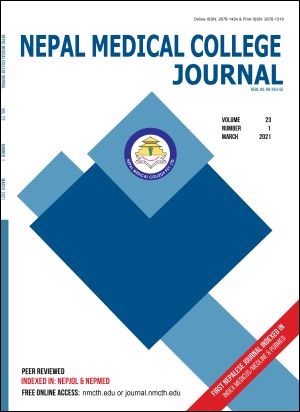Assessment of Health Seeking Behavior Regarding Complementary and Alternative Medicine in Solukhumbu District, Nepal
DOI:
https://doi.org/10.3126/nmcj.v23i1.36223Keywords:
Curse of God, evil spirits, Dhamijhakri, Jharphuke, Jadibooti, NepalAbstract
The objective of the study was to assess the health seeking behavior of the people regarding complementary and alternative medicine (CAM) in remote area Dhudhakaushika, Gaunpalika of Solukumbu District during April – August 2017. The sample size was 300 (129 male and 171 female). Semi-structured question was design and Focus Group Discussion (FGD) was conducted. The results indicated that about three fourths of the respondents visited a modern medical institution 224 (74.7%), a little under one-half 129 (43.0%) visited Dhami-Jhakri and 85 (28.3%) contacted the Jharphuke who chanted a Mantra over a sick adult or child. Around 33 (11.0%) contacted the female community health volunteer (FCHV), 20 (6.7%) used domestic medicine or ethno- medicine, 13 (4.3%) visited a pharmacy and 9(3.0%) visited a private allopathic clinic when they felt discomfort. Respondents ascribed the cause of the disease to supernatural causes or evil spirits (53.3%), to germs (48.7%), curse of God (83.0%) to sins committed in the past (10.3%), and other causes (5.7%). The respondents usually consulted at first Dhami-Jhakri (43.0%) and Jharphuke (28.3%) when they fell sick. People utilized CAM in order to relieve undesired pain, uneasiness in the body and restore the health condition. The types of alternative medicine utilized by the respondents were Ayurveda 162 (54.0%), jadi-booti 248 (82.7%), homeopathy 94 (31.3%), relaxation 33 (11.0%), and meditation 68 (22.7%) healing touch 55 (18.3%), therapeutic massage 109 (36.3%), acupuncture 126 (42.0%), acupressure 44 (14.7%) Yoga 28 (3.3%) and 10 (3.3%) did not know any practice other than Dhamijhakri. Through the FGD, it was observed that traditional medicine sector was an important source of health care in Solukhumbu. The main reasons for consulting a CAM healer were the proximity, affordable barter system, availability, family pressure and the strong opinion of the community. In conclusion, CAM use especially self-treatment with medicinal plants was found to be a common practice along with modern medicine in a rural setting in Nepal. The study findings emphasized the reality of multiple recourse adopted by health care seekers and their deeply entrenched belief in CAM. Nepal has a very rich tradition in the use of medicinal plants for the treatment of various ailments. This may indicate the need for the integration of the modern and CAM systems in terms of evidence-based information sharing. This calls for bringing CAM healers into the mainstream by providing them with proper training, facilities and referral services. The healers can motivate the persons to access modern health care services by placing a Tika of ash (Kharani) prior to referral. A positive interaction between the two systems has to be harnessed to work for the common goal of improving health of the people.
Downloads
Downloads
Published
How to Cite
Issue
Section
License
This license enables reusers to distribute, remix, adapt, and build upon the material in any medium or format, so long as attribution is given to the creator. The license allows for commercial use.




